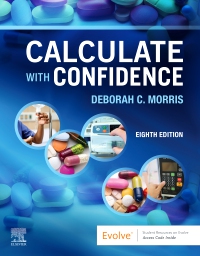
Calculate with Confidence Elsevier eBook on VitalSource, 8th Edition
Elsevier eBook on VitalSource

Help your students learn to make accurate drug calculations and administer medications safely! Calculate with Confidence, 8th Edition makes it easy to understand the three major methods of dosage calculation — ratio and proportion, formula method, and dimensional analysis. Clear, step-by-step instructions guide students through accurate calculation and safe administration of drug dosages. Thousands of practice problems ensure that students gain proficiency, QSEN principles prioritize client safety, and an emphasis on clinical reasoning helps in preventing medication errors. New Next Generation NCLEX® (NGN) case studies help students improve their clinical judgment skills. With this popular text, students will learn to calculate drug dosages and administer medications with confidence.
Newer Edition Available
Calculate with Confidence - Elsevier E-Book on VitalSource
-
- NEW! Five single-episode Next Generation NCLEX® (NGN) case studies are added to the book.
- NEW! QSEN content is now included In Unit One, Math Review.
- NEW! Updated medication labels are included.
- NEW! Discussion of herbal meds is included in the Medication Administration chapter.
- NEW! Latest research and information is included in the Insulin, Critical Care Calculations, and Pediatric and Adult Dosage Calculation Based on Weight chapters.
- NEW! Updated information on the administration of fluids is added.
- NEW! Updated information and examples of complex I&O problems are added to the Intake and Output section of the text, and it also includes more examples of complex I&O problems.
- NEW! Updated Medication Index includes the latest drug information and removes drugs that are off the market or are not widely used.
- Thousands of practice problems ensure student proficiency with drug calculations and include pre-test and comprehensive post-test review.
- Safety Alert boxes highlight issues that may lead to medication errors and help students learn actions to avoid errors in calculation.
- Tips for Clinical Practice boxes call out information critical to math calculation and patient safety, and summarize best practices in client care (a Clinical Judgment feature for the NGN).
- Rule boxes present instructions essential to math calculations and provide the information needed to accurately solve drug calculation problems.
- Clinical Reasoning Scenarios discuss the safe administration of medications (also a Clinical Judgment feature for the NGN).
- Comprehensive Post-Test assesses students' retention of the "big picture" concepts, with answers located in the back of the book.
- Pre-test basic math, unit post-tests, and basic math review tests allow students to evaluate their understanding of the basic math material covered in Unit 1, directing them to review chapters for remediation.
- Medication Administration chapter covers medication safety, a discussion on client rights, the basic six rights of medication administration, and routes of medication administration.
- Chapter review problems test student comprehension of all major topics, with the answers at the end of the chapter.
- Points to Remember list bulleted key points from the chapter.
-
- NEW! Five single-episode Next Generation NCLEX® (NGN) case studies are added to the book.
- NEW! QSEN content is now included In Unit One, Math Review.
- NEW! Updated medication labels are included.
- NEW! Discussion of herbal meds is included in the Medication Administration chapter.
- NEW! Latest research and information is included in the Insulin, Critical Care Calculations, and Pediatric and Adult Dosage Calculation Based on Weight chapters.
- NEW! Updated information on the administration of fluids is added.
- NEW! Updated information and examples of complex I&O problems are added to the Intake and Output section of the text, and it also includes more examples of complex I&O problems.
- NEW! Updated Medication Index includes the latest drug information and removes drugs that are off the market or are not widely used.
-
Unit One: Math Review
Pre-Test
1. Fractions
2. Decimals
3. Ratio and Proportion
4. Percentages
Post-Test
Unit Two: Systems of Measurement
5. Metric System
6. Apothecary and Household Systems
7. Converting Within and Between Systems
8. Additional Conversions Useful in the Health Care Setting
Unit Three: Methods of Administration and Calculation
9. Medication Administration
10. Understanding and Interpreting Medication Orders
11. Medication Administration Records and Drug Distribution Systems
12. Reading Medication Labels
13. Dosage Calculation Using the Ratio and Proportion Method
14. Dosage Calculation Using the Formula Method
15. Dosage Calculation Using the Dimensional Analysis Method
Unit Four: Oral and Parenteral Dosage Forms, Insulin and Pediatric Dosage Calculations
16. Calculation of Oral Medications
17. Parenteral Medications
18. Reconstitution of Solutions
19. Insulin
Unit Five: Intravenous, Heparin, and Critical Care Calculations and Pediatric Dosage Calculations
20: Intravenous Solutions and Equipment
21. Basic Intravenous Calculations
22. Heparin Calculations
23. Critical Care Calculations
24. Pediatric and Adult Dosage Calculation Based on Weight
Comprehensive Post-Test
Bibliography
Appendix A: Apothecary System
Appendix B: FDA and ISMP Lists of Look-Alike Drug Names with Recommended Tall Man Letters
Appendix C: TJC’s “Do Not Use” List of Abbreviations
Appendix D: ISMP’s List of Error-Prone Abbreviations, Symbols, and Dose Designations
Appendix E: ISMP List of High-Alert Medications in Acute Care Settings
Appendix F: ISMP List of High-Alert Medications in Community/Ambulatory Healthcare
Index
Drug Label Index





 as described in our
as described in our 